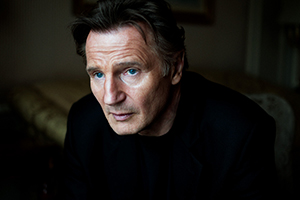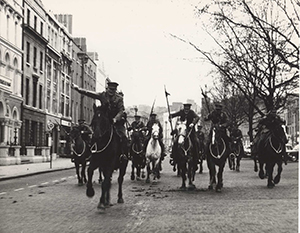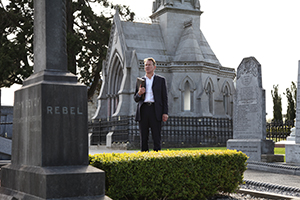1916
Published in Issue 3 (May/June 2016), Reviews, Volume 24Coco Television/Keough Naughton Institute for Irish Studies, University of Notre Dame
RTÉ1, February 2016
Briona Nic Dhiarmada, The 1916 Irish rebellion (Cork University Press, 216pp, €29.95 hb, ISBN 9781782051916). Foreword by Mary McAleese.
By John Gibney

Narrator Liam Neeson provided 1916 with Hollywood star power. (James Mooney)
1916 is a major three-part documentary on the Easter Rising, drawing upon the considerable financial and academic resources of the University of Notre Dame, an army of experts and Hollywood star power in the form of narrator Liam Neeson. It has been produced to coincide with the centenary of the Easter Rising, which is finally upon us and has been the source of much agonising and gnashing of teeth in op-ed columns, letters to editors and social media. It has been depicted, depending on whom one listens to, as both perfectly rational and utterly insane, as an event that happened either in splendid isolation or as an integral element of the Great War, as the assertion of a people seeking their just rights or a usurpation of democracy, as the essential precondition for Irish independence or a colossal mistake that derailed Home Rule—even, and surprisingly in our secular age, as a form of blasphemy that would surely meet with the stern disapproval of the dead generations in the form of St Thomas Aquinas. The Irish public has been implored to ruminate upon the meaning of 1916 for quite some time. Indeed, the cry has increasingly gone up in various quarters that people are sick to death of hearing about the Rising, that 1916 fatigue was setting in even before the clock ticked down to the centenary (a complaint that, curiously, nobody seemed to venture about the ongoing commemorations of the First World War). Much of this commentary has been neither as informed as it should be nor as clever and original as it thinks it is.
What does any of it have to do with this documentary?
It has a great deal to do with it, for by spearheading this production the Keough Naughton Institute for Irish Studies at the University of Notre Dame has done a very considerable service to public discourse on the Easter Rising. One might venture the proposition that what has become tiresome in recent years is not 1916 in itself so much as commentators seeking to debate the meaning of 1916. There is a public appetite for learning about the Easter Rising, as in actually finding out what happened, warts and all (witness the success of Joe Duffy’s book on the child victims of the Rising), rather than being told what they should think and feel about it, and being berated for not agreeing with a range of diverse prejudices. There is a gap for a good, solid, well-made, academically respectable, accessible and up-to-date account of what happened in Ireland at Easter 1916. Notre Dame has provided it.
The story itself need not be rehearsed here. The three episodes of 1916 comprise a TV history of the origins, course and impact respectively of the Easter Rising; it is not a potted general history, nor a history of Home Rulers, Ulster Unionism or the Irish in the First World War. The focus thus dictates the selection of topics and themes, but a selection is not the same as being selective; it in no way misleads. This is a polished, exceptionally well-made production. The first episode fills in a back story extending back to the Norman conquest, with a wide (and stellar) range of interviewees (it is refreshing to see and hear 1916 being discussed by people who actually know what they are talking about). If the first episode can seem inevitably dutiful, 1916 springs to life in the second, dealing with the actual events of the Rising itself, and many of the academic talking heads make way for interviews with survivors and veterans from all sides. 1916 does not lean upon reconstructions or dramatisations (apart from some footage from RTÉ’s fabled Insurrection). Instead, it deploys an extraordinary and painstakingly assembled array of unfamiliar contemporary images and footage (some of which are reproduced in the accompanying book). Given the amount written on the Rising, directors Briona Nic Dhiarmada and Ruan Magan have done a hugely impressive job of stripping back the story to its bare essentials and relating it in a coherent manner that assumes no prior knowledge, and with a refreshing lack of polemic.

Above: RTÉ’s semi-legendary Insurrection was finally rebroadcast (18–25 March 2016) and turns out to have stood the test of time. The central conceit, of rolling live coverage of the Easter Rising, worked surprisingly well for something that was far ahead of its time—though sharp-eyed viewers might have noticed the parked cars and the bus stop behind this dramatic image of British lancers charging down Sackville/O’Connell Street. (RTÉ Stills Library)

Above: Michael Portillo at the Glasnevin graveside of ‘rebel’ John Devoy in RTÉ’s The Enemy Files (21 March). While elements in British public life don’t seem to have entirely forgiven us for 1916, Michael Portillo did an admirable job of both getting to grips with it and exploring the Easter Rising from a British perspective. (RTÉ)
The third and final episode deals with the aftermath, as the military defeat of the Rising was transformed into the political victory of a new independence movement. Ireland was not the only small country to gain independence from a larger power after the First World War. The difference is that Irish independence was secured from one of the victorious empires and not from one of the defeated ones. This gives 1916 a global significance, as the Irish independence movement came to be seen as an inspiration to nationalist movements throughout the British Empire, especially in India (though, as noted by Kate O’Malley, Nehru was more enthused by it than Gandhi). The focus looks beyond 1922 to cast an eye on the independent Ireland that emerged, though the suggestion that the revolution was betrayed was accepted a tad uncritically. It is certainly true that some, though not all, of the leaders had visions for Ireland’s future that stood in stark contrast to the reality of the remarkably stable albeit conservative state that emerged after the Rising. But is the revolution that Ireland got simply the revolution that most Irish people wanted? While a coda extending up to the Belfast Agreement of 1998 seems to hint at a happy ending in which everyone gets along, 1916 ends on an ambiguous note: Ronan Fanning teases out the possibility that what makes the Rising politically awkward is not reactionary unease at the betrayal of a radical revolution but the simple stark fact that the Easter Rising shows how political violence can sometimes succeed. The last word goes to Bulmer Hobson, who observed that the historians might sift through the facts but they would always continue to co-exist with the myths. There will, of course, be those for whom no criticism of the Rising can ever be acceptable, and others for whom no criticism of it can ever be enough. But those who want to make up their own minds can do so in an informed fashion by watching this. There are some minor factual glitches, but this is a sophisticated, very watchable and exceptionally well-made overview of a seminal event in Irish history.
John Gibney is currently Glasnevin Trust Assistant Professor of Public History and Cultural Heritage at Trinity College Dublin.
















